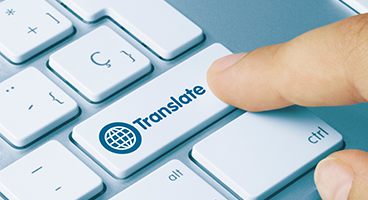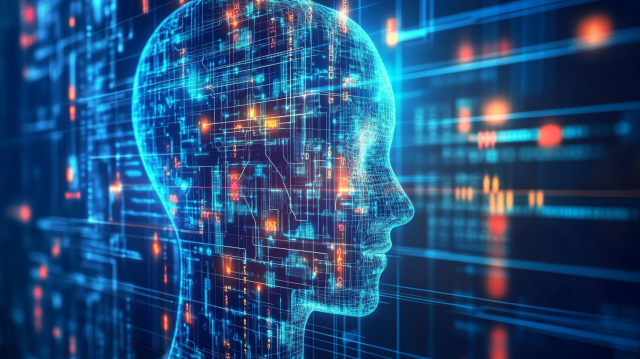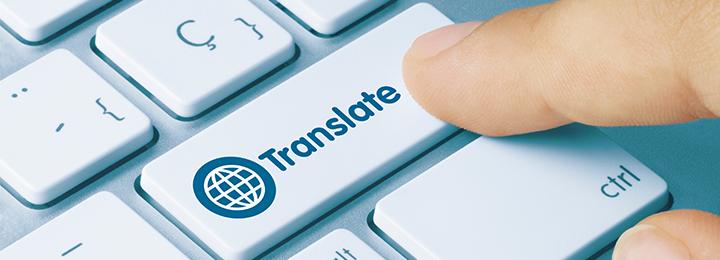
- Table of Contents
-
- 1. What is machine translation?
- 2. The Mechanism of Machine Translation
- 3. Advantages and Disadvantages of Machine Translation
- 4. Latest Trends in Machine Translation
- 5. Representative Machine Translation: DeepL and Google Translate
- 6. Translation Accuracy Comparison
- 7. Points to Consider When Using Machine Translation for Business
- 8. Summary
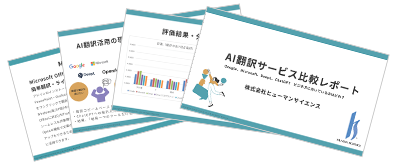
1. What is machine translation?
Machine translation is a technology that uses computer programs to automatically translate text written in one language into another language. It is also known as automatic translation, MT (Machine Translation), or AI translation. Well-known services include DeepL and Google Translate. Currently, it is used not only in research and business but also in everyday situations such as browsing foreign news and during travel. Machine translation can be easily accessed through built-in translation features in web browsers and translation apps for smartphones, and its convenience has led to its widespread adoption.
Thanks to machine translation, information gathering and communication have become easier. Regardless of language, it has become easy to access information and content from around the world, allowing for instant access to the latest information. Additionally, it has enabled communication with people who speak different languages, making international exchange more accessible. Machine translation is utilized in education and business, not only aiding in studying abroad and overseas business trips but also contributing to information gathering in research and development, as well as improving communication with overseas partners.
The terms "machine translation" and "automatic translation" are often used interchangeably, but they are strictly differentiated. First, the term "machine translation" generally refers to translation technology or the translation process itself. For example, the latest translation algorithms utilizing neural networks and research and development activities aimed at improving translation accuracy fall under "machine translation." This can be considered a term focused on the technical aspects and processes.
On the other hand, "machine translation" often refers to translation systems or services provided primarily for users. In particular, it often refers to systems that perform translations in real-time without user intervention, such as translation features built into web browsers or real-time voice translation functions in smartphone apps. Since these translations are performed automatically without special user actions, the term "machine translation" is appropriate.
2. The Mechanism of Machine Translation
There are mainly three types of mechanisms for machine translation.
• Rule-based Machine Translation
We perform translations using linguistic rules and dictionaries. Through morphological analysis, syntactic analysis, and semantic analysis, we generate sentences in the target language.
• Statistical Machine Translation
Learn statistical patterns from a large bilingual corpus and perform translations using probabilistic models. There are approaches such as word-based, phrase-based, and syntax-based.
• Neural Translation
Using deep learning technology, we learn language conversion through neural networks. We capture the meaning of sentences and grammatical relationships with comprehensive vector representations, achieving more natural translations.
For details on these translation methods, please see the page below.
>How Machine Translation Works: Literal Type, Free Translation Type, and Neural Translation?
3. Advantages and Disadvantages of Machine Translation
The advantages of machine translation include speed as the first point. Machine translation can perform translations much faster than human translators, allowing for the translation of large amounts of text in a short time. Additionally, it can be used at a lower cost compared to hiring a translation company. Furthermore, it supports multiple languages, and some services can translate over 100 languages.
The disadvantages of machine translation include issues with accuracy. Machine translation is not perfect and can struggle to accurately capture cultural backgrounds and expressions, making the translated text sound awkward. Additionally, for texts that strongly depend on context, mistranslations are more likely to occur. Therefore, it is not recommended to use documents translated by machines as is, and human verification is essential. It is especially advisable to outsource important documents and contracts to a specialized translation company.
4. Latest Trends in Machine Translation
The machine translation market was valued at 153.8 million dollars in 2020 and is expected to grow at an average annual rate of 7.1% from 2021 to 2026, reaching 230.67 million dollars by 2026 (Source: Mordor Intelligence "Machine Translation Market - Growth, Trends, COVID-19 Impact, and Forecast (2022-2027)"). In Japan, DeepL has gained attention in recent years, and the adoption of machine translation by companies is increasing.
5. Representative Machine Translation: DeepL and Google Translate
DeepL is a machine translation service released by the German company DeepL in 2017. Initially, it only supported European languages, but in March 2020, it added support for Japanese. DeepL has been providing the translation search engine Linguee, and by combining the bilingual data collected there with deep learning, it has achieved a high-precision machine translation service.
Google Translate is a machine translation service released by Google in 2006. Initially, the translation accuracy was not very high, but in November 2016, it was revamped with a system called Google Neural Machine Translation (GNMT), which uses deep learning, significantly improving the accuracy for languages such as Chinese and Japanese. Machine translation has been in use for over 20 years, but the introduction of Google Neural Machine Translation has further accelerated the utilization of machine translation.
6. Translation Accuracy Comparison
Our company evaluates machine translation services from DeepL, Google, Microsoft, and Amazon in the fields of IT, healthcare, machinery, contracts, and patents, and calculates BLEU scores. The BLEU score is a numerical representation that mechanically compares translations produced by machine translation with those translated from scratch by humans (reference translations) to determine similarity. The range is from 0 to 1, with values closer to 1 indicating greater similarity to the reference translation. Even if the meaning is the same, differences in words or expressions will lower the score, but it correlates with human evaluation, and higher values are considered to indicate greater accuracy of machine translation. As a guideline, a score of 0.3 or higher suggests that it is faster to correct the machine-translated text than to translate from scratch (though this depends on quality requirements).
The evaluation results are as follows.
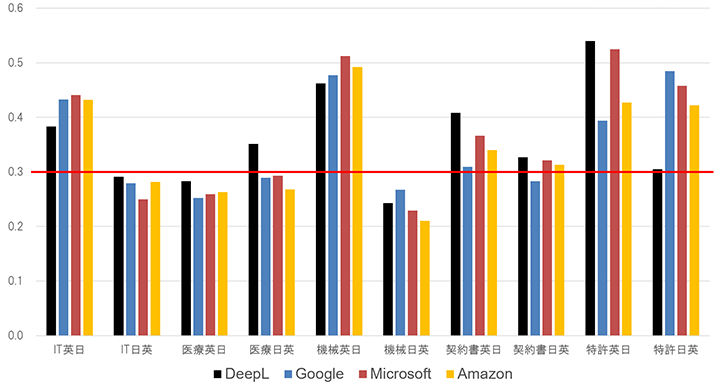
DeepL excels in IT Japanese-English, medical English-Japanese and Japanese-English, contract English-Japanese and Japanese-English, and patent English-Japanese translations. While DeepL has a good reputation, it is evident that other machine translation services like Google and Microsoft may perform better depending on the field and language direction. It is recommended to use different machine translation services based on the field and language direction. Additionally, even within the same field, the types of documents vary, and the required translation quality differs. For a reliable evaluation, it is advisable to translate and assess actual business documents.
For information on email translation accuracy, please see the following article.
>How accurate is DeepL? Comparison results with Google and Microsoft for business emails
7. Points to Consider When Using Machine Translation for Business
When introducing machine translation into business, it is important to consider security aspects. There are many automatic translation services available for free on the internet, but most free services do not guarantee confidentiality. Using free services may result in the input text or documents being reused, and this applies to DeepL and Google Translate as well. Translating confidential information using free machine translation services can lead to data leaks, which is prohibited by many companies.
For more information on DeepL's security, please see "Is confidentiality maintained with DeepL translation? What about security?".
When using machine translation, business terms may not be translated correctly. This is especially common in highly specialized fields or cutting-edge areas where mistranslations of terms are often seen. Machine translation services come equipped with glossary features that allow you to specify translations for specific terms. To avoid mistranslations of terms, it is recommended to use the glossary feature.
For more information about DeepL's glossary, please see "DeepL's glossary supports Japanese".
8. Summary
The emergence of DeepL has brought attention to machine translation services, accelerating their use in corporations. Several companies offer machine translation services, and the translation accuracy varies depending on the field and documents being translated. From a confidentiality standpoint, it is not recommended to use free machine translation services in corporations.
Human Science offers an automatic translation software called "MTrans for Office" that utilizes translation engines from DeepL, Google, Microsoft, and OpenAI. OpenAI can not only translate but also generate, rewrite, and proofread text depending on the prompt, supporting business efficiency and multilingual capabilities. MTrans for Office also offers a 14-day free trial. Please feel free to contact us.

Features of MTrans for Office
- ① Unlimited number of file translations and glossary integration for a fixed fee
- ② One-click translation from Office products!
- 3. API connection ensures security
- For customers who want further enhancement, we also offer SSO, IP restrictions, and more. - ④ Support in Japanese by Japanese companies
・Response to security check sheets is also possible
・Payment via bank transfer is available
MTrans for Office is an easy-to-use translation software for Office.

